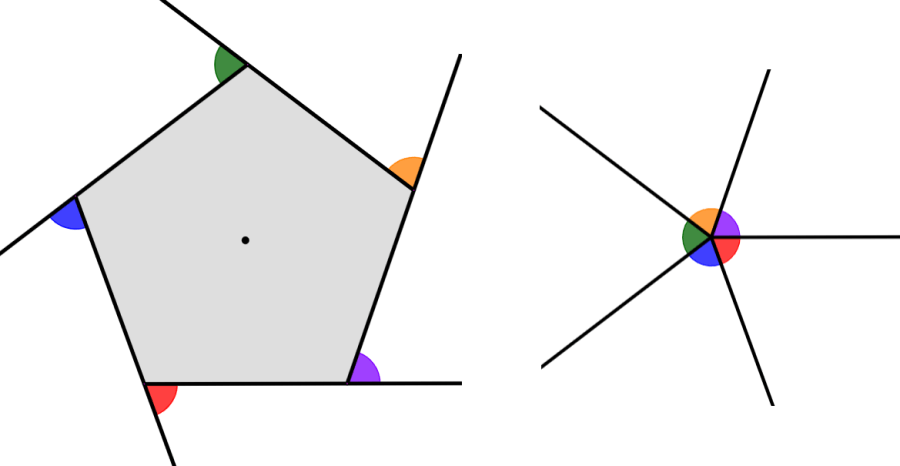The interior angles of a regular polygon can be calculated using a formula. This formula allows us to calculate their sum based on the number of sides of the polygon. On the other hand, the sum of the exterior angles of any polygon is always equal to 360°. Therefore, the measure of each angle is calculated by dividing by the number of sides of the regular polygon.
Here, we will learn about the formulas that we can use to determine the internal and external angles of a polygon.
Calculate the measure of the interior angles of a polygon
The measure of each internal angle in a regular polygon can be calculated starting from the total sum of the internal angles. For its part, the sum of the internal angles of any polygon is calculated using the following formula:
| $latex (n-2)\times 180$° |
where n is the number of sides of the polygon. For example, in the case of a hexagon, we use $latex n = 6$.
We can use this formula to calculate the sum of the interior angles of any polygon, regardless of whether it is regular or irregular. For example, if we have a hexagon, which has six sides, we have:
$latex (n-2)\times 180$°
$latex =(6-2)\times 180$°
$latex =(4)\times 180$°
$latex =720$°
In the following table, we can look at the sum of interior angles of some important polygons:
| Polygon | Number of sides | Sum of angles |
| Triangle | 3 | 180° |
| Quadrilateral | 4 | 360° |
| Pentagon | 5 | 540° |
| Hexágono | 6 | 720° |
| Heptagon | 7 | 900° |
| Octagon | 8 | 1080° |
The measure of each internal angle in a regular polygon is found by dividing the total sum of the angles by the number of sides of the polygon. For example, we saw that the sum of the interior angles of a hexagon equals 720°. Therefore, when we divide by 6 (sides in a hexagon), we have:
720°÷6=120°
Each interior angle of a regular hexagon measures 120°.
Alternatively, we can determine the measure of an interior angle in a regular polygon using the following formula:
| $latex \frac{(n-2)\times 180}{n}$ |
where n is the number of sides of the regular polygon.
The following is a table with the interior angles of important polygons:
| Polygon | Each angle |
| Triangle | 60° |
| Square | 90° |
| Pentagon | 108° |
| Hexagon | 120° |
| Heptagon | 128.57° |
| Octagon | 135° |
Calculate the measure of the exterior angles of a polygon
The exterior angles of a polygon are formed when we extend the sides of the polygon. Therefore, these angles are formed as in the following diagram:

We can see that all the exterior angles of a polygon have a total sum of 360°. Therefore, we can calculate the measure of one of the exterior angles of a regular polygon by dividing 360° by the number of sides of the regular polygon. For example, for a pentagon, we have:
360°÷5 = 72°
Each exterior angle of a regular pentagon measures 72°.
Examples of interior and exterior angles of a polygon
EXAMPLE 1
What is the measure of an internal angle of a regular decagon?
Solution: A decagon is a 10-sided polygon, so we use the interior angle formula with $latex n = 10$. Therefore, we have:
$latex \frac{(n-2)\times 180}{n}$
$latex =\frac{(10-2)\times 180}{10}$
$latex =\frac{(8)\times 180}{10}$
$latex =\frac{1440}{10}$
$latex =144$°
The measure of each internal angle of a regular decagon is equal to 144°.
EXAMPLE 2
Find the measure of the exterior angles of a regular hexagon.
Solution: A regular hexagon has 6 sides, so we have to divide the sum of exterior angles by 6 since all the angles are equal:
360°÷6 = 60°
The measure of each exterior angle of a regular hexagon is equal to 60°.
See also
Interested in learning more about the interior angles of a polygon? Take a look at these pages:
- Interior Angles of a Hexagon – Formula and Examples
- Exterior Angles of a Hexagon – Formula and Examples
- Sum of Interior Angles of a Hexagon
- Interior Angles of a Heptagon – Formula and Examples
- Interior Angles of a Trapezoid – Formula and Examples
- Sum of Interior Angles of a Polygon – Formula and Examples




